
Planning is not Strategy
Planning is Comfortable. Strategy isn’t.
I am a big fan of the Harvard Business Review. Sometimes its articles make me feel cynical; others make me exclaim in delight. But “The Big Lie of Strategic Planning,” by Roger Martin in the January-February 2014 edition left me feeling downright vindicated.
When we started Conservation Impact eighteen years ago, we pioneered our one-page strategic plan. Our belief was (and continues to be) that being strategic is about focus and making hard choices about what you will and won’t do. If you engage in planning that is truly strategic, you don’t need more than a page or two. But being strategic can also be very uncomfortable – to the extent that I often tell my clients or trainees that working with us might make the feel a little nauseated!
So you can imagine how it felt all these years later to read this in Martin’s article:
“You need to be uncomfortable and apprehensive. True strategy is about placing bets and making hard choices. The objective is not to eliminate risk but to increase the odds of success.”
Yes!
As a leader in your organization or agency, it is critically important to understand that planning and strategy are two different things, as Martin’s article articulates so well. It is equally important that you don’t let yourself be dissuaded by the temporary discomfort that comes from making strategic decisions.
Creating Plans that are Truly Strategic
Completing a strategic plan every 3-5 years is considered a best practice among land trusts and other nonprofits – and such planning cycles are ubiquitous among public health agencies and coalitions. Minimally, these plans serve as tools to recalibrate around current situations and to set new goals.
We have found that our clients’ plans are truly strategic only when they address fundamental issues and make clear, deliberate decisions about them. To emphasize this, we often refer to the planning process as strategic decision-making rather than strategic planning.
Making strategic decisions is difficult. The process is uncomfortable and imperfect. Martin describes it as the:
“…result of a simple and quite rough-and-ready process of thinking through what it would take to achieve what you want and then assessing whether it’s realistic to try.”
In an ever-changing environment, no amount of planning ensures success. However, the role of leadership is not to set the organization on the safest path. Instead good leaders seek to understand that environment and chart a course that is focused on impact and resiliency.
Useful strategic decision-making sessions involve thoughtful, impassioned, and data-informed deliberation about possible strategies, culminating in clarity and committed decisions. Such discussions aren’t about making everyone feel good or incorporating everyone’s opinion. Remember, this is about decision-making. Yes or no. This way or that way. Not sort of, maybe, or perhaps.
Strategic decisions should represent the best choices for your organization at a particular point in time based upon the best available data, relevant trends, and solid, objective analysis. The resulting strategy should allow for creativity and innovation. It needs to be flexible and adaptable as situations change, as opportunities or obstacles arise, or as mid-term results warrant.
Get Reacquainted with Strategy
Our Integrated Strategy for Success and Sustainability provides a useful framework that can help you home in on your core strategic issues:
- Who are we and what difference do we intend to make?
- Who are our constituents and what do they need and want?
- What is your capacity in resources and competence to deliver results and have meaningful impact?
Starting with an understanding of your core issues gives your organization a solid base from which to start making strategic decisions about those issues and clarifying your best strategy moving forward. Now that’s a plan!
Image by Steve Roberts

